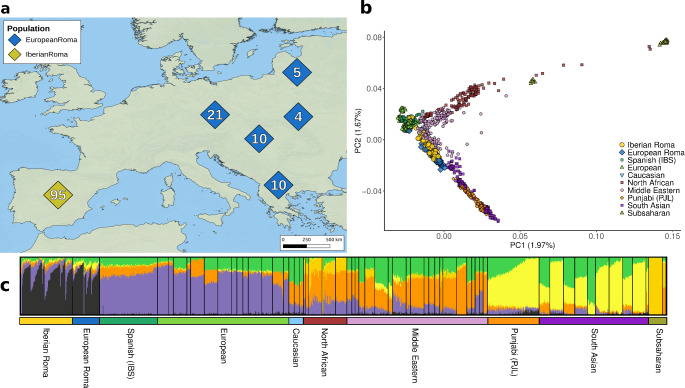Roma people from the Iberian Peninsula show genetic differences compared to those from the rest of Europe despite their common origin
Roma people from the Iberian Peninsula show genetic differences compared to those from the rest of Europe despite their common origin
Roma people from the Iberian Peninsula show genetic differences compared to those from the rest of Europe despite their common origin

A study carried out involving 110 volunteer Iberian Roma people and a further thirty from the rest of Europe yields the most complete genomic analysis to date of the Roma people and, for the first time, confirms that they mainly mate with members of their community, although over time they have also mixed with non-Roma populations, especially in the Iberian Peninsula. Furthermore, the study confirms that they migrated to Europe in a single wave from India in historical times, thus ruling out the possibility of being of Jewish or North African origin. The study was led by David Comas, with Giacomo Francesco Ena as first author, both attached to the Department of Medicine and Life Sciences (MELIS) at Pompeu Fabra University and to the Institute of Evolutionary Biology (IBE, CSIC-UPF).
Compared to Roma people in the rest of Europe, the Iberian population shows a higher genomic proportion from southwestern Europe, where they reside, and a lower proportion of southeastern Europe and southern Asia, where they come from. This shows that they have mixed more with non-Roma people in the Peninsula than the rest of European Roma with populations in Europe. “These differences may be related to cultural traditions and legislative impositions that have affected Roma groups differentially”, David Comas points out.
Moreover, genomic analysis reveals that the Roma people from a particular geographical region of the Iberian Peninsula mate more among themselves than with Roma from other regions, which does not occur among non-Roma people on the Peninsula.
“It is an inbred, but not a closed community”
The researchers have described a recent increase in miscegenation that previous studies had not detected. This increase began some five generations ago in the case of the Iberian Roma, and about ten years ago among those in the rest of Europe. In any case, the genomic analysis suggests that migrations and interbreeding were continuous during the 18th and 19th centuries throughout Europe, and greater than was initially thought: “It is an inbred, but not closed community”, Comas explains.
Confirmation that the Roma people come from India
Genetic research is one of the latest methods to learn about Romani history, in addition to linguistic studies and historical records. The analysis carried out at UPF shows that the genome of all European Roma groups has two thirds of ancestors from western Eurasia and one third from southern Asia, which coincides with previous studies that place the origin of the Roma people in the Indian subcontinent.
This, together with the absence of genetic variants of Jewish and North African ancestry among the European Roma population, rules out the hypothesis of a Jewish origin or a North African genetic influence. “The Roma diaspora is the result of a single migratory wave that went from India to the Balkans, where they arrived 1,000 years ago, and later from the Balkans to the rest of Europe and the Iberian Peninsula, where they have been for more than 600 years”, Comas clarifies.
2025: 600 years since the arrival of the Roma people in the Iberian Peninsula
Currently, there are no really precise censuses of the number of Roma people in Europe; but it is estimated that they are between 10 and 15 million. One of the most numerous populations is found in the Iberian Peninsula, with a million individuals, where they are known as calés. The first documentary records of their presence are found in Zaragoza, in 1425. Thus, this year marks the 600th anniversary of the Roma people in the iberian Peninsula. However, this genetic study has shown that they arrived in the Peninsula slightly earlier, between 625 and 650 years ago.
The Roma people travelled from India through the Middle East to the Balkans less than a thousand years ago. A history of persecution and enslavement began then in several European countries, culminating in the Nazi genocide. Around 600 years ago they reached the Iberian Peninsula at a turbulent time when Christians, Jews and Muslims were living together. However, the genetic data do not unveil a genetic influence of Jews and North Africans on the current Roma populations. Although the Roma people were initially welcomed to the Peninsula, they were quickly forced to settle in specific areas and their freedom was limited. In 1749, during the “Great Round-Up” or “General Imprisonment of the Roma”, thousands of Roma were arrested and imprisoned. Despite being full citizens, unfortunately the Roma people still suffer socioeconomic inequalities compared to the rest of the population.
Reference article: Ena GF, Giménez A, Carballo-Mesa A, Lišková P, Araújo Castro E Silva M, Comas D. The genetic footprint of the European Roma diaspora: evidence from the Balkans to the Iberian Peninsula. Hum Genet. 2025 Apr;144(4):463-479. doi: 10.1007/s00439-025-02735-z. Epub 2025 Mar 17. PMID: 40095094; PMCID: PMC12003505.
